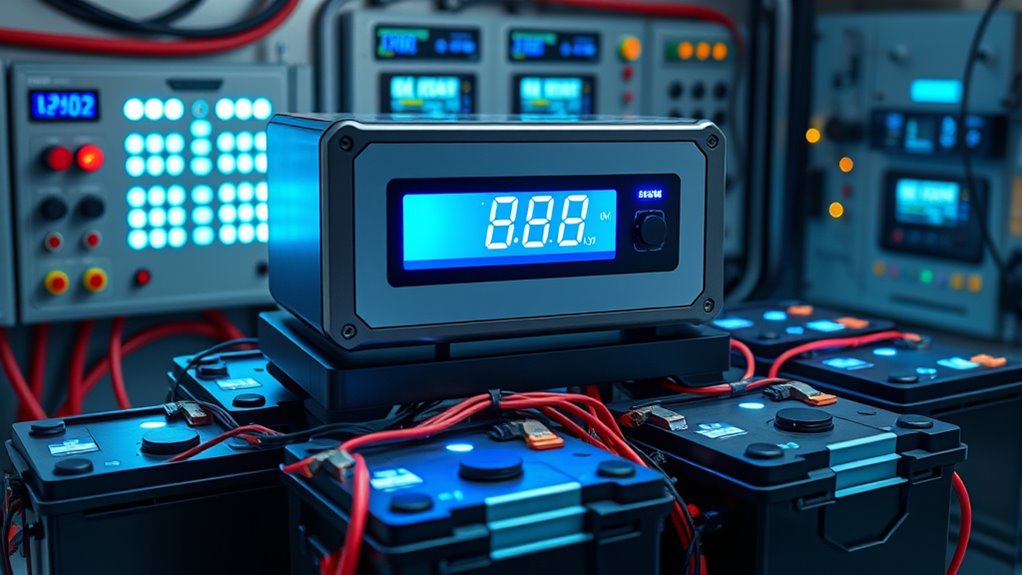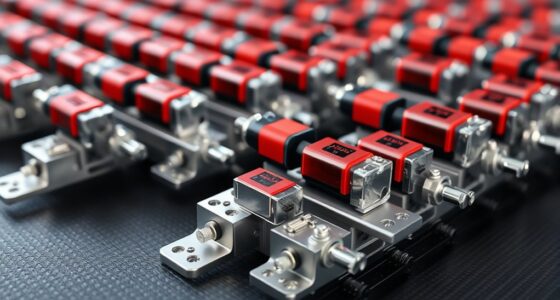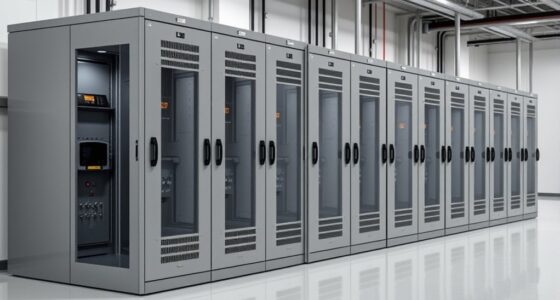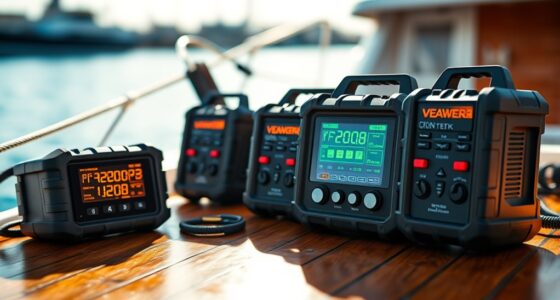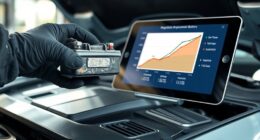If you’re looking to optimize your power systems in 2025, I recommend exploring the top 15 battery balancers that offer active, passive, and multi-voltage balancing solutions. These devices help extend battery life, improve efficiency, and guarantee stability across various chemistries like lithium and lead-acid. From simple equalizers to advanced BMS with monitoring, there’s something for every setup. Keep going to discover the best options that fit your needs and elevate your energy management.
Key Takeaways
- The list includes a variety of active, passive, and automatic battery balancers suitable for different voltages and battery chemistries.
- It highlights devices with monitoring features for real-time voltage and health tracking to optimize battery lifespan.
- The selection covers small-scale, DIY-friendly units as well as large-scale systems for professional and off-grid applications.
- Many balancers support multiple chemistries like LiFePO4, lead-acid, and lithium-ion, ensuring versatile compatibility.
- The top products emphasize safety, ease of installation, durability, and energy efficiency to enhance power system performance in 2025.
MOTOPOWER MP00205B 12V 1000mA Battery Charger, Maintainer & Desulfator
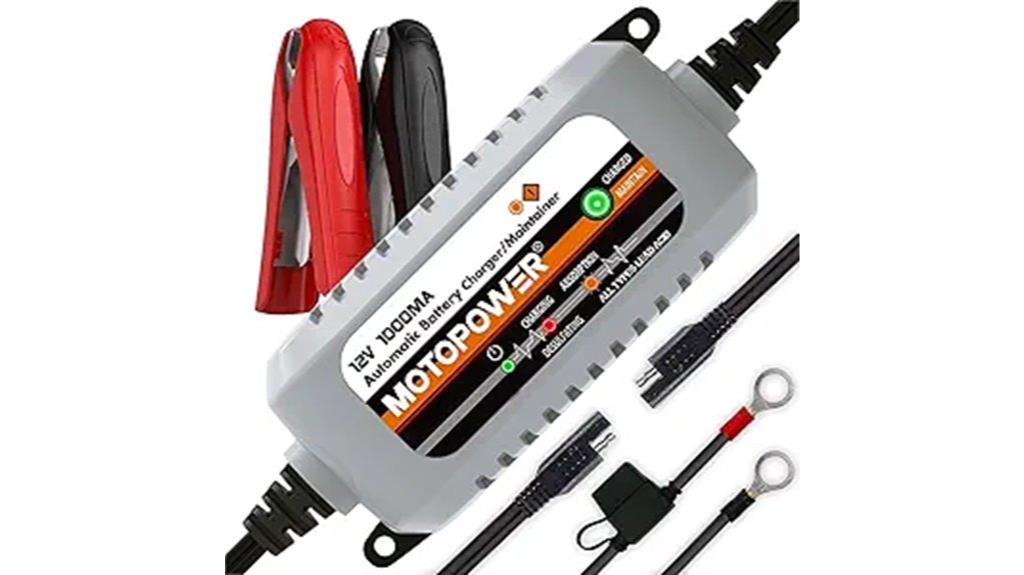
If you’re looking for a reliable, easy-to-use charger that can keep your 12V lead-acid batteries in top shape, the MOTOPOWER MP00205B is an excellent choice. This compact device functions as a charger, maintainer, and desulfator, making it versatile for various batteries used in motorcycles, cars, lawn mowers, and generators. Its pulse charging technology gently boosts battery performance and extends lifespan, while safety features like overcharge protection and spark-free operation ensure peace of mind. Certified by CE, RoHS, UL, and CEC, it’s energy-efficient and simple to install with multiple connection options. Users love its effectiveness and ease of use, making it a solid addition to your maintenance toolkit.
Best For: DIY enthusiasts and vehicle owners seeking a safe, reliable, and energy-efficient solution to maintain and revive 12V lead-acid batteries in motorcycles, cars, lawn mowers, and generators.
Pros:
- Utilizes pulse charging technology to extend battery lifespan and improve performance.
- Fully automatic with overcharge protection and spark-free operation for safe use.
- Certified by CE, RoHS, UL, and CEC, ensuring safety and energy efficiency.
Cons:
- Not a fast charger; ideal for maintenance rather than quick charging needs.
- Some users report concerns about clip quality and durability.
- Customer support experiences vary, with occasional delays in response.
ISDT BattGo BG-8S Battery Meter with LCD Display
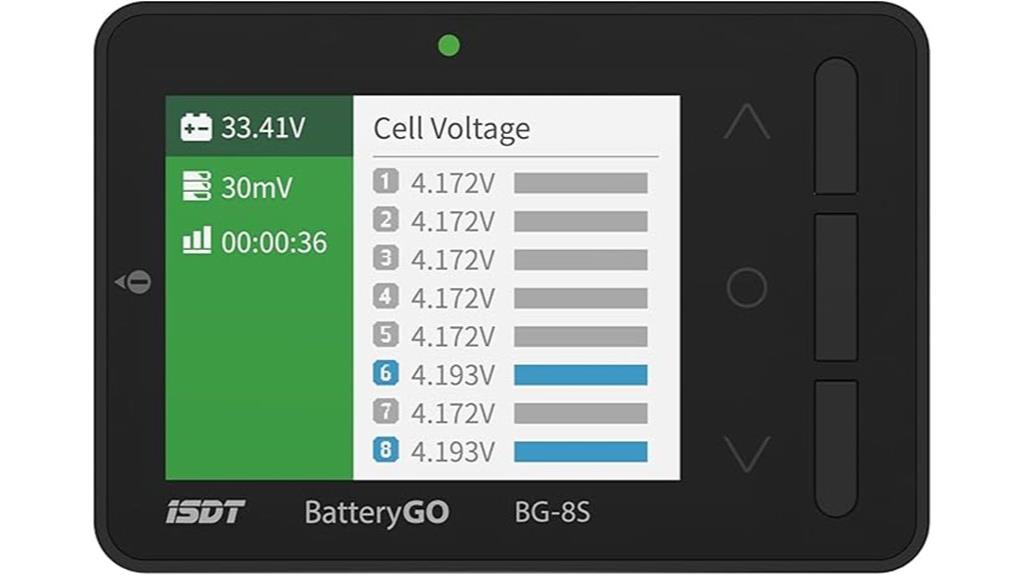
The ISDT BattGo BG-8S Battery Meter with LCD Display stands out as a top choice for hobbyists and professionals seeking precise, real-time battery monitoring. It supports multiple connections, including XT60/XT60i and 2-8S balance, and works with various battery types like LiPo, LiHv, NiMH, and NiCd. Its BattGO technology provides detailed parameters such as cell voltages and cycles when connected via XT60i. The auto balancing feature helps optimize battery lifespan by preventing cell imbalances, and it also functions as a portable power bank supporting quick charging. Compact and lightweight, it combines versatility with ease of use, making it an essential tool for any power system.
Best For: hobbyists and professionals who need precise, real-time monitoring and management of various battery types and configurations.
Pros:
- Supports multiple battery types and connection options, including XT60/XT60i and 2-8S balance measurement.
- Equipped with auto balancing to enhance battery lifespan and prevent cell imbalance.
- Functions as a portable power bank with quick charging capabilities, adding versatility.
Cons:
- Limited to a maximum output of 12V/2A, which may not suit high-power applications.
- Requires connection via XT60i to access detailed parameters, which may necessitate additional adapters.
- The device’s small size and multifunctionality might have a learning curve for new users.
Active Balancer for Lifepo4 Batteries (Heltec BMS 4S-8S)
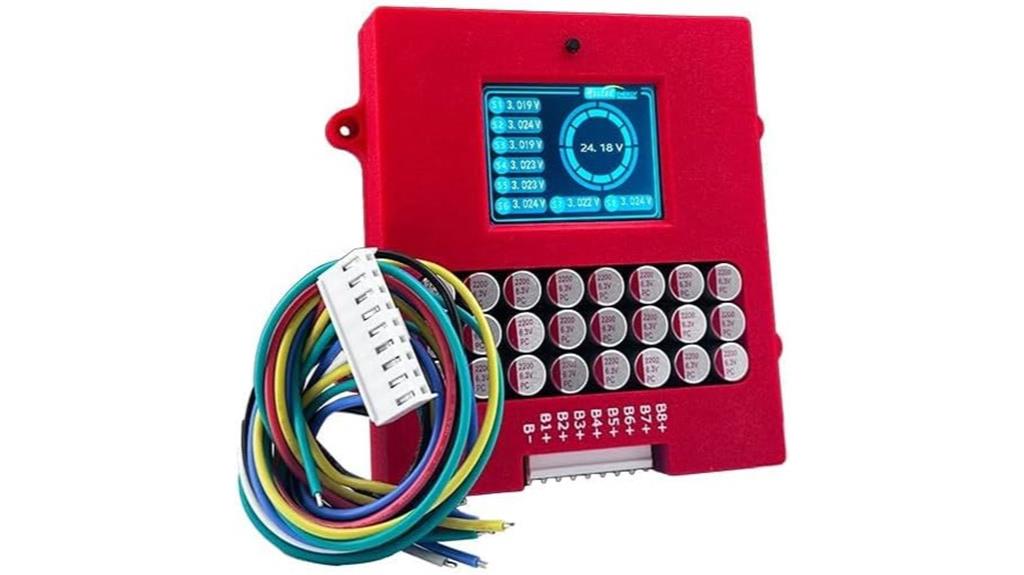
For those seeking an efficient and versatile active balancer for Lifepo4 batteries, the Heltec BMS 4S-8S stands out thanks to its wide compatibility and advanced features. It supports ternary lithium, LiFePO4, and LTO batteries, with voltage ranges from 1.8V to 4.5V per cell and capacities up to 300AH. Its capacitor transfer principle guarantees reliable equalization, while ultra-low resistance MOSFETs and a 2OZ copper PCB optimize performance. The adjustable current (0-5.5A) provides flexibility, and the built-in protections—like under-voltage sleep—enhance safety. Easy to monitor, it’s a smart choice for maintaining balanced, efficient power systems.
Best For: DIY enthusiasts and professionals seeking a reliable, high-capacity active balancer for Lifepo4, LiFePO4, and LTO battery systems with customizable current and advanced safety features.
Pros:
- Wide compatibility supporting 4S to 8S battery configurations and capacities up to 300AH
- Precise balance voltage within 5mV and adjustable current up to 5.5A for tailored balancing
- Low quiescent current and sleep mode for energy efficiency and safety during idle periods
Cons:
- May require technical knowledge for installation and operation due to its advanced features
- Manual sleep switch and settings may need user familiarity for optimal use
- Limited to specific battery chemistries, potentially less suitable for other types of batteries
Battery Equalizer BM102S
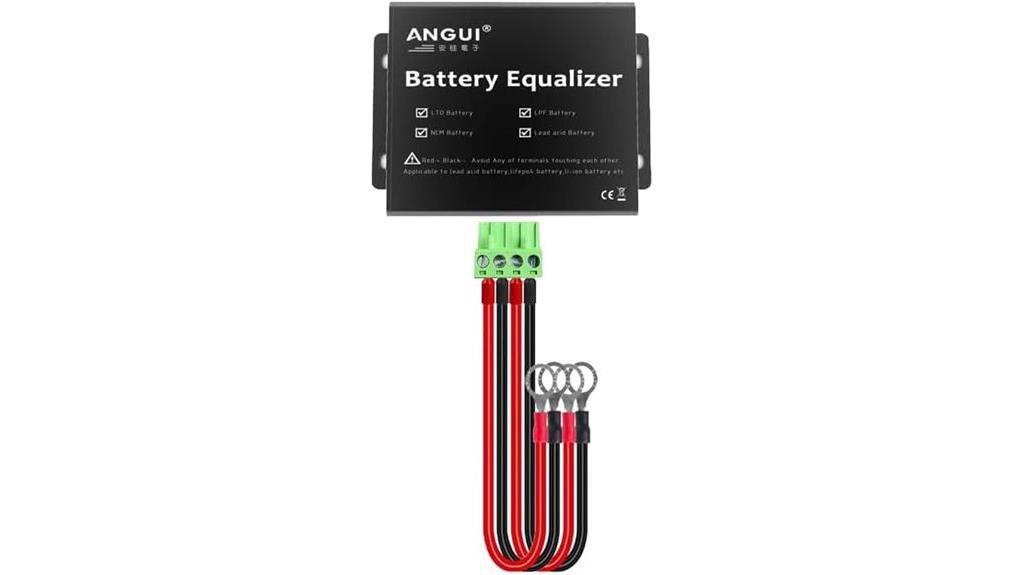
The Battery Equalizer BM102S stands out as an ideal choice for users managing 24V power systems with two 12V batteries, thanks to its active voltage balancing capability. This device effectively balances voltage across both batteries, ensuring peak performance and longevity. It functions as a balancer, charger, discharge regulator, and inverter, making it versatile for various applications. Its compact size (6.89 x 4.33 x 1.57 inches) and lightweight design (12.3 ounces) make installation simple. With a solid reputation as a top seller in solar and wind power inverters, the BM102S offers reliable support and a warranty, giving me confidence in its durability.
Best For: users with 24V battery systems consisting of two 12V batteries seeking efficient voltage balancing, charging, and overall system management.
Pros:
- Combines multiple functions (balancer, charger, discharge regulator, inverter) in one compact device
- Enhances battery performance and longevity through active voltage balancing
- Easy to install with its lightweight and small form factor
Cons:
- Limited to 24V systems with two 12V batteries, not suitable for larger or different configurations
- May require technical knowledge for optimal setup and integration
- Availability and warranty details depend on the seller, which could affect post-purchase support
ECO-WORTHY 48V Battery Equalizer for 24V/36V/48V Battery Banks
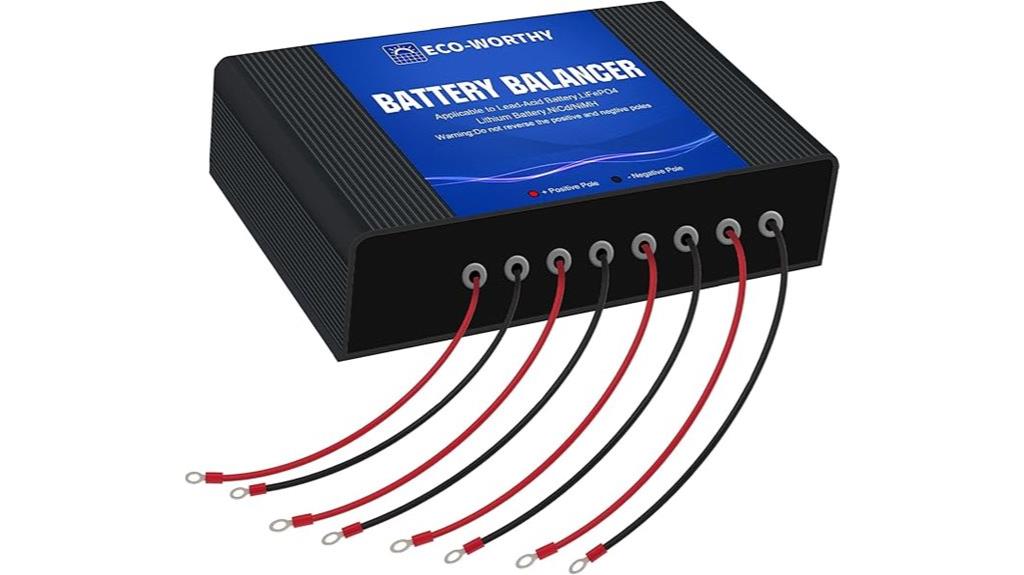
If you’re managing a series-connected battery bank with voltages of 24V, 36V, or 48V, the ECO-WORTHY 48V Battery Equalizer stands out as a reliable choice. It supports various battery types, including LiFePO4, lead-acid, gel, SLA, and others, making it versatile for different setups like motorcycles or cars. The equalizer automatically activates when voltage differences exceed 10 millivolts, ensuring continuous balancing. It enhances battery capacity, extends lifespan, and prevents issues caused by uneven charge levels. While it’s easy to install and offers solid performance, some users note a high-pitched noise and build quality concerns, which are worth considering.
Best For: individuals with series-connected 24V, 36V, or 48V battery banks seeking a versatile, automatic balancing solution compatible with various battery types.
Pros:
- Supports multiple battery chemistries including LiFePO4, lead-acid, gel, SLA, nickel-metal hydride, and nickel-cadmium.
- Automatically activates when voltage differences exceed 10 millivolts, ensuring continuous balancing.
- Enhances battery capacity, lifespan, and performance by maintaining voltage equilibrium across batteries.
Cons:
- Some users report a high-pitched whining noise during operation, which can be bothersome.
- Lacks visual indicators such as LEDs to show operational status.
- Concerns about build quality and potential device failure after warranty expiration.
Victron Energy Battery Balancer
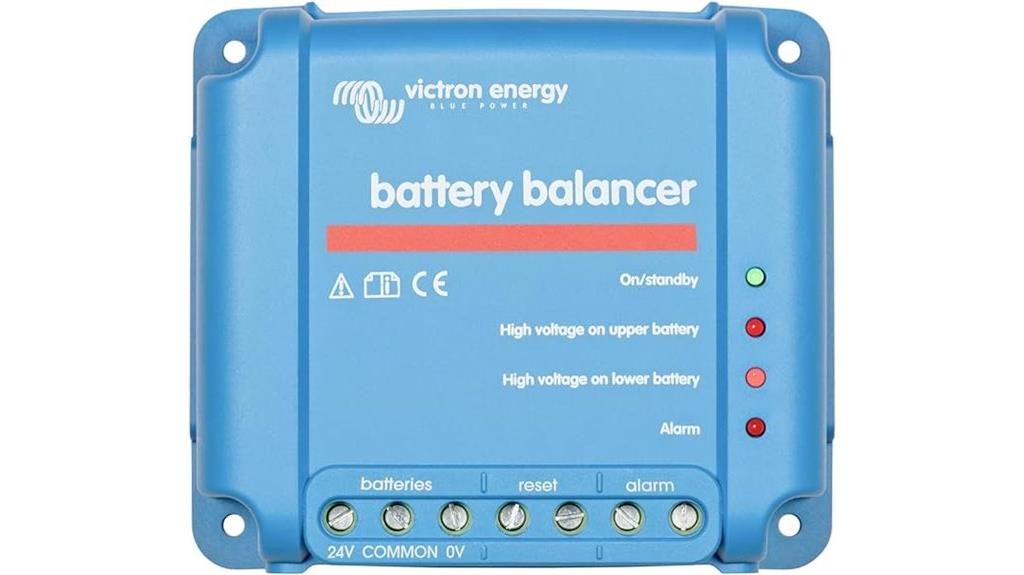
Victron Energy Battery Balancer stands out for its simplicity and effectiveness in maintaining battery balance within 2S configurations. It automatically equalizes charge by drawing up to 1A from the highest-voltage battery once system voltage exceeds 27V. This helps extend the lifespan of your battery bank by preventing load imbalance. Designed mainly for 2S setups, it’s easy to install, though using multiple units for larger systems can be costly and less coordinated. Compatible with LiFePO4 batteries and various configurations, it’s a reliable, straightforward solution for balancing adjacent batteries, especially in smaller or simpler power systems.
Best For: users with 2S battery configurations seeking a simple, reliable solution to maintain battery balance and extend battery life.
Pros:
- Easy to install and operate, ideal for small or simple systems.
- Effectively balances adjacent batteries by drawing up to 1A from the highest-voltage cell.
- Compatible with LiFePO4 batteries and various configurations, providing flexibility.
Cons:
- Limited effectiveness in 4S or larger systems due to lack of communication between units.
- Requires multiple units for larger setups, increasing overall cost.
- Installation may require additional wiring and accessories, with manual providing limited guidance for complex configurations.
PowMr 48V Battery Equalizer and Voltage Balancer for 4×12V or 8×12V Battery Banks
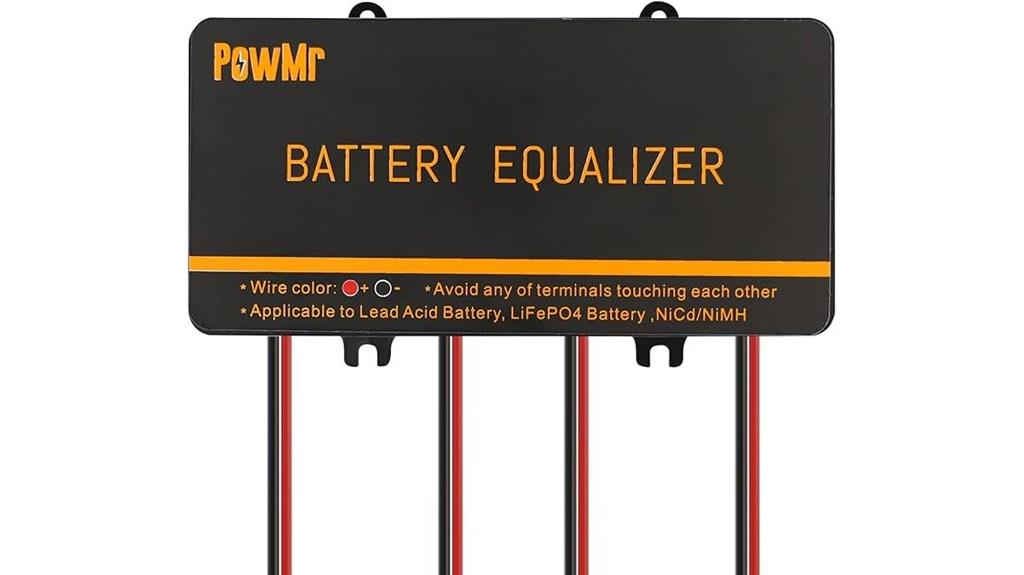
When managing a 48V battery system with multiple 12V batteries, the PowMr 48V Battery Equalizer and Voltage Balancer stands out as a reliable choice. It supports 4×12V or 8×12V batteries, whether connected in series or parallel, and automatically balances voltages to improve lifespan and efficiency. With a 10A current and 480W power capacity, it’s suitable for various applications like solar setups, RVs, boats, and electric vehicles. Its compatibility with gel, flood, AGM, and lithium batteries, combined with IP65 protection, makes it durable outdoors. Users report effective balancing, ensuring batteries stay within 0.1V, boosting performance and longevity.
Best For: individuals or professionals managing large 48V battery banks in solar, RV, marine, or electric vehicle applications seeking an automatic, durable, and efficient balancing solution.
Pros:
- Supports multiple battery configurations (4×12V or 8×12V) with automatic balancing for improved lifespan
- Compatible with various battery types including gel, flood, AGM, and lithium, offering versatile use
- IP65 rated enclosure ensures durability for outdoor or harsh environments
Cons:
- Fragile plastic casing may require careful handling during installation
- Some users report faint high-pitched noise during operation
- Slight continuous current draw (~1-2W) could lead to minor temperature increases and potential safety considerations
LiTime 48V Battery Equalizer for Lithium and Lead Acid Batteries

The LiTime 48V Battery Equalizer stands out as a versatile solution for those building or maintaining large battery banks, thanks to its support for multiple battery types—including LiFePO4, lithium-ion, and lead acid—within a 3-20V range. It’s ideal for creating 48V systems by connecting 16 batteries in series-parallel. With active balancing, it automatically detects voltage differences and works until they’re below 10mV, ensuring balanced performance. Its easy installation, safety protections, and ability to extend battery lifespan make it a reliable choice for RVs, solar setups, and off-grid systems. Many users report improved runtime and system stability with minimal effort.
Best For: those building or maintaining large, multi-type battery banks such as RV owners, solar system installers, and off-grid enthusiasts seeking reliable active balancing solutions.
Pros:
- Supports a wide range of battery types including LiFePO4, lithium-ion, and lead acid, enhancing versatility
- Automatic balancing extends battery lifespan and improves system performance with minimal user effort
- Easy installation process typically completed within 15 minutes, suitable for various applications
Cons:
- Some users report minor noise or absence of indicator lights, which may affect monitoring
- Potential for product defects or shipping packaging issues, requiring support or replacements
- Effectiveness can vary depending on initial battery conditions and setup, possibly requiring additional indicators or monitoring tools
Redodo 24V Battery Balancer with LED Display for LiFePO4, Lead Acid, Gel Batteries

Redodo’s 24V Battery Balancer stands out with its intuitive LED display, making it easy to monitor voltage levels in real-time. I can see at a glance how each battery is performing, which helps me maintain ideal system health. This device automatically balances series-connected batteries by reducing pressure differences, supporting up to 10A of equalization current. It’s compatible with various battery types like LiFePO4, GEL, and lead acid, making it versatile for different setups. Plus, its dual protections prevent reverse polarity and overheating, ensuring long-term durability. Installation is straightforward with included cables, and the one-year warranty gives me confidence in its reliability.
Best For: Home energy storage, RV owners, solar system enthusiasts, marine and off-grid setups, and anyone using 24V battery systems who needs real-time monitoring and automatic balancing.
Pros:
- Easy-to-read LED display for real-time voltage monitoring of each battery
- Supports multiple battery types including LiFePO4, GEL, and lead acid, offering versatile application options
- Automatic balancing with protection features like reverse polarity and high-temperature safeguards
Cons:
- Limited to a maximum equalization current of 10A, which may be insufficient for very large battery banks
- Installation requires handling of electrical connections, which might be challenging for beginners
- Only provides a 1-year warranty, potentially requiring additional support or replacement after this period
MAZAVA HC02 Battery Equalizer for 12/24/36/48V Batteries
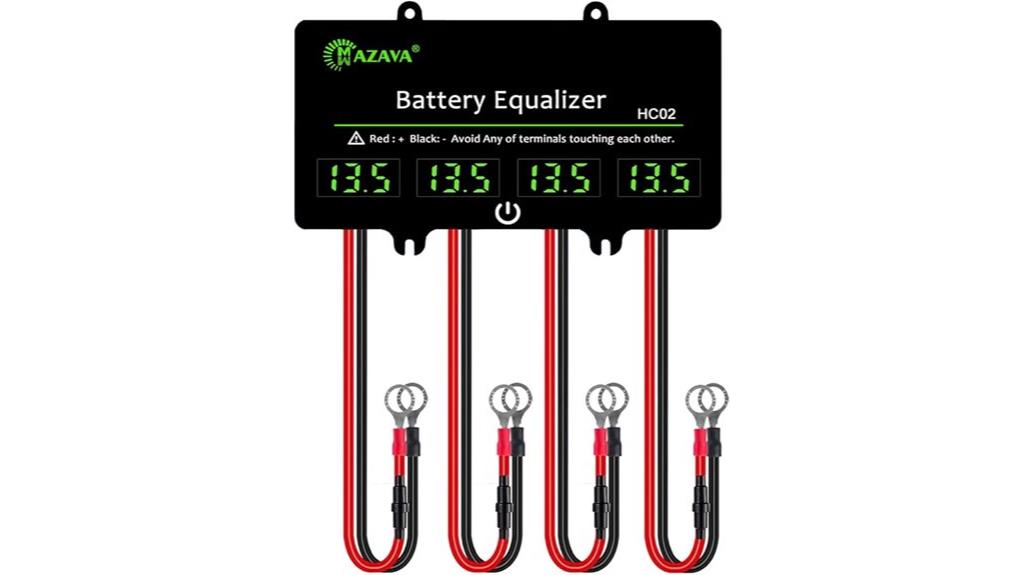
If you need a versatile battery equalizer that supports multiple voltages, the MAZAVA HC02 is a solid choice. It works with 12V, 24V, 36V, and 48V batteries, functioning as a voltage balancer and active lead-acid touch switch controller. Its compact size and built-in display make it easy to monitor voltage levels and keep batteries balanced. While users find it effective over time, some report durability issues like broken fuse holders and inconsistent readings. Despite its reliability concerns, it can help extend battery lifespan in applications like golf carts and solar systems, provided you operate it carefully and keep expectations realistic.
Best For: DIY enthusiasts and small-scale solar or battery system users seeking a versatile, multi-voltage battery equalizer to maintain battery health and performance.
Pros:
- Supports multiple voltages (12V, 24V, 36V, 48V), making it suitable for various battery setups
- Compact design with a built-in display for easy voltage monitoring
- Helps extend battery lifespan by maintaining balanced charge levels over time
Cons:
- Reports of durability issues such as broken fuse holders and damaged components
- Inconsistent voltage readings and potential for units to burn out quickly
- Limited measurement precision (one decimal point) compared to professional multimeters
RoyPow 12V Battery Charger (3-Amp Automatic Smart Maintainer)
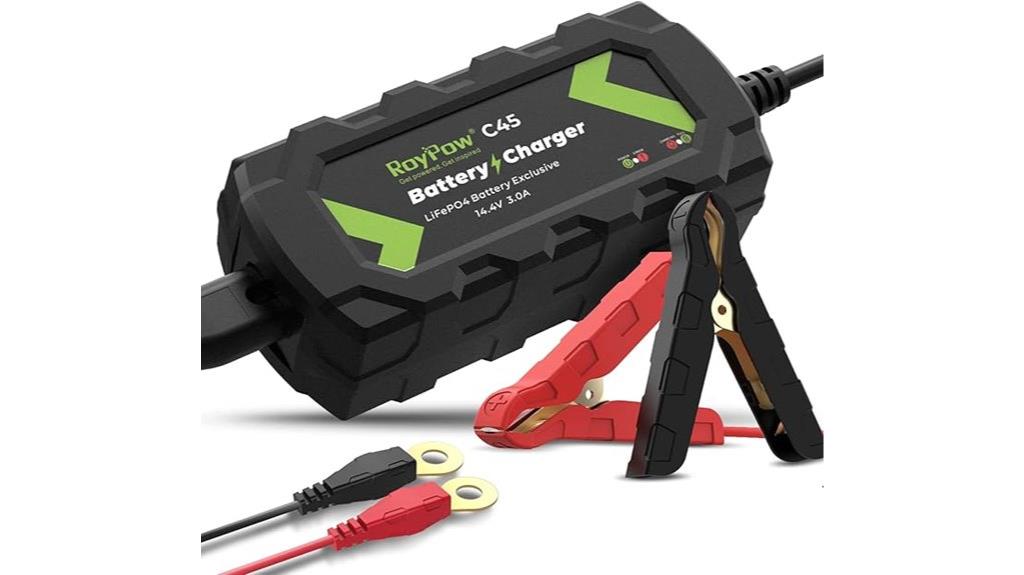
For anyone seeking a reliable and user-friendly charger for 12V batteries, the RoyPow 12V Battery Charger stands out with its smart automatic maintenance feature. This lightweight, 150g device supports all 12V lithium batteries, including lead-acid, AGM, gel, and deep cycle types, making it versatile for automotive, marine, RV, and outdoor equipment. It automatically switches to trickle charge once the battery is full, ensuring continuous maintenance without manual intervention. With safety protections against short circuits, overcurrent, reverse connections, and more, it’s a safe and efficient choice. Plus, it features easy operation, indicator lights, and includes all necessary accessories for hassle-free use.
Best For: DIY enthusiasts and vehicle owners seeking a reliable, versatile, and safe 12V battery charger for various lithium and lead-acid batteries.
Pros:
- Supports all 12V lithium batteries, including lead-acid, AGM, gel, and deep cycle types.
- Automatically switches to trickle charge upon full capacity, ensuring continuous maintenance.
- Incorporates multiple safety protections such as short circuit, overload, and reverse connection safeguards.
Cons:
- Relies on indicator lights which may not provide detailed charging information.
- May be less suitable for batteries outside the specified 12V range or non-lithium types.
- Lacks advanced features like Bluetooth connectivity or smartphone app integration.
AYNEFY Dual Battery Pack Switch Balancer
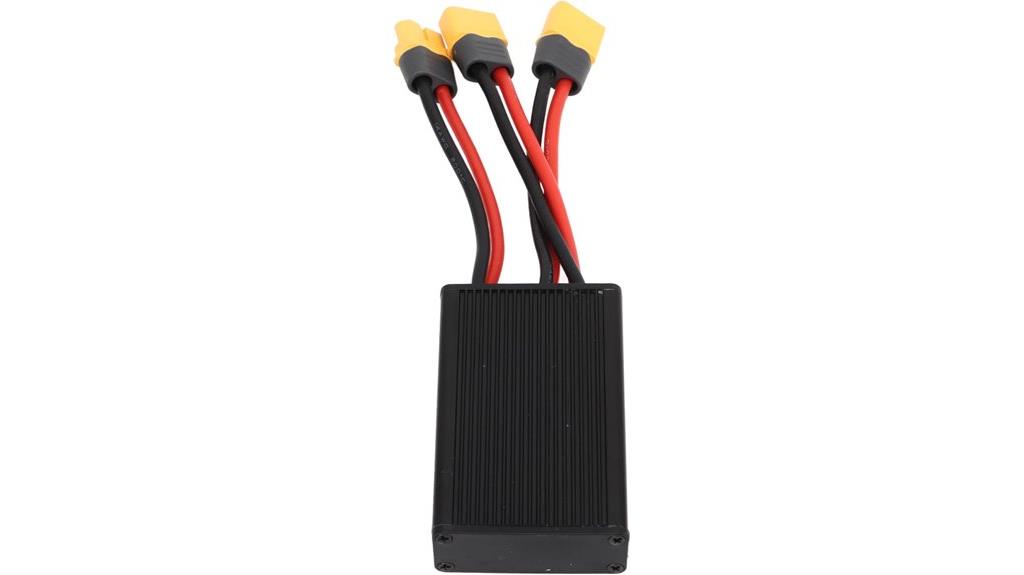
The AYNEFY Dual Battery Pack Switch Balancer stands out for those seeking flexible and efficient power management for electric bikes, thanks to its support for two batteries. It allows you to manage dual packs or a single battery, boosting current capacity and discharge rates simultaneously. Made from durable lightweight aluminum alloy, it ensures longevity and reliable performance. Its interface features a male port for battery input and a female port for connecting to your controller, compatible with 20V–72V batteries. At just over 6 inches long and weighing 105 grams, it’s a compact, powerful solution to optimize your e-bike’s power system.
Best For: electric bike enthusiasts seeking flexible, high-capacity power management solutions for dual or single battery setups.
Pros:
- Supports dual battery management for increased power and flexibility
- Made of durable, lightweight aluminum alloy for long-lasting use
- Compatible with a wide voltage range of 20V–72V, suitable for various e-bike systems
Cons:
- May require technical knowledge for proper installation and setup
- Limited to applications within the specified voltage range, not suitable for all battery types
- Slightly bulky size may require additional space in compact e-bike frames
100BALANCE BMS 40A Active Balance Battery Protection Board
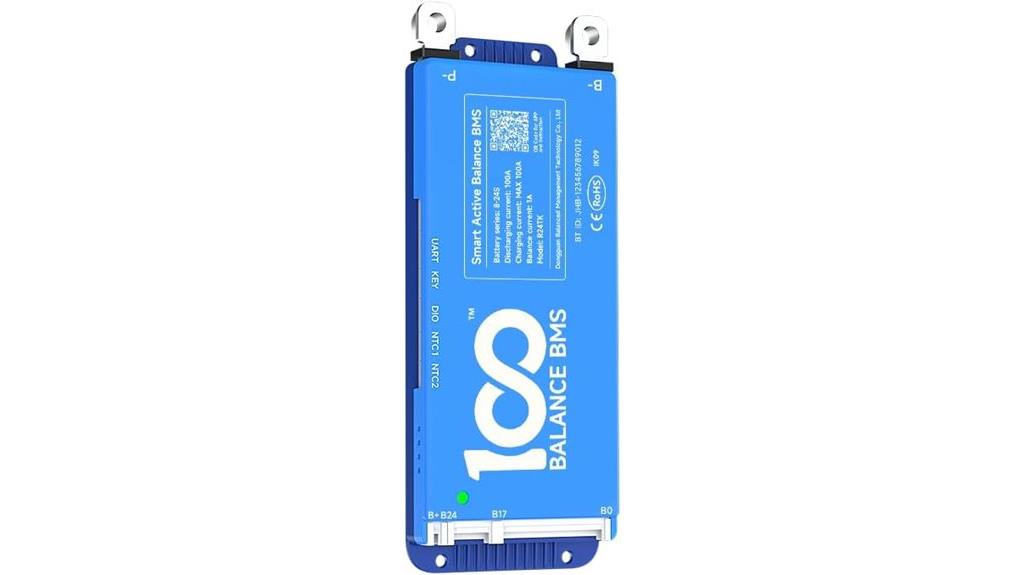
The BALANCE BMS 40A Active Balance Battery Protection Board stands out with its Bluetooth connectivity, allowing users to monitor and adjust settings via a mobile app on Android and iOS devices. I find it easy to track voltage, current, and temperature, making setup straightforward. It supports 8S-24S configurations, compatible with 24V-84V packs, and includes protections against overcharge, overdischarge, overcurrent, short circuits, and temperature issues. The device features quick cell balancing, pre-charge protection, and simple wiring, making it ideal for electric vehicles, energy storage, and backup power. Its compact design and reliable performance earn praise, though some users note overheating concerns at higher discharge rates.
Best For: hobbyists and DIY electric vehicle builders seeking a reliable, Bluetooth-enabled BMS with comprehensive protections and easy installation for 8S-24S lithium battery packs.
Pros:
- Supports multiple battery chemistries with active balancing and safety protections.
- Bluetooth connectivity allows for real-time monitoring and easy configuration via mobile app.
- Compact design with straightforward wiring, suitable for various applications like e-bikes and energy storage.
Cons:
- Some users report overheating issues at higher discharge currents, such as 10A.
- Lack of detailed product review videos from the manufacturer may hinder consumer confidence.
- Difficulties in switching between battery chemistry modes and active balancing activation failures have been noted.
Victron Energy Battery Balancer
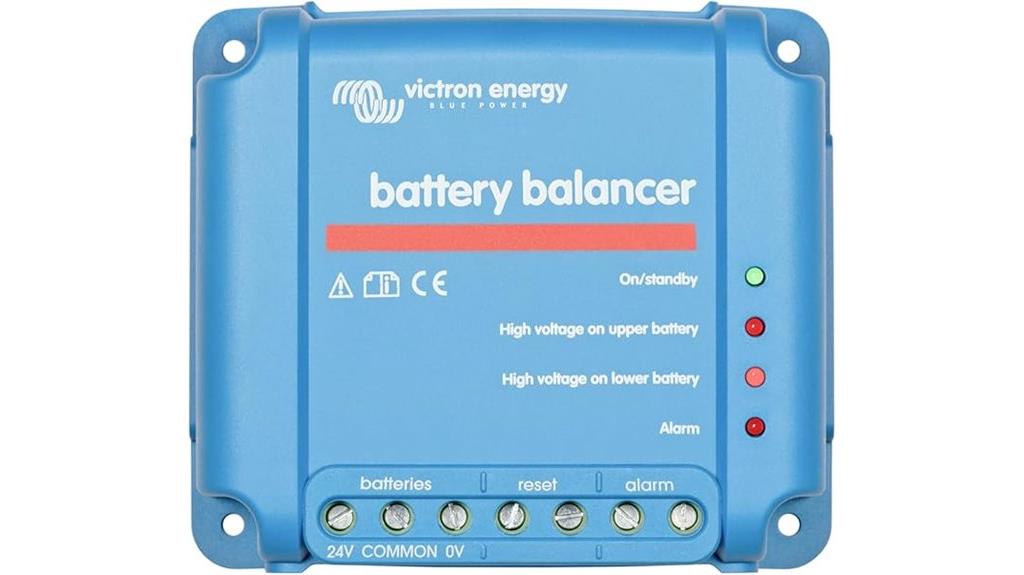
Looking for a reliable battery balancer that effectively extends your battery bank’s lifespan? The Victron Energy Battery Balancer is a solid choice. It equalizes charge across two series-connected 12V batteries or multiple parallel strings, activating when voltage exceeds 27V. It draws up to 1A from the highest-voltage battery, ensuring all batteries reach similar charge levels. Suitable for 2S setups, it’s straightforward to install, though multiple units are needed for larger systems, which can be costly. While it works well in LiFePO4 systems, it has limitations with 4S configurations due to lack of communication between units. Overall, it’s reliable but best suited for simpler, smaller banks.
Best For: users with small to medium 2S battery banks seeking a reliable, easy-to-install balancer to extend battery lifespan.
Pros:
- Effectively balances two series-connected batteries, improving overall battery health
- Simple installation process suitable for 2S configurations
- Durable, reliable build with positive customer reviews
Cons:
- Limited to 2S setups; multiple units needed for larger systems, increasing cost
- Lacks communication between units, causing imbalance issues in 4S or multi-string configurations
- No included cables or accessories, requiring additional purchases for installation
Battery Equalizer for Lead-Acid and Lithium Batteries
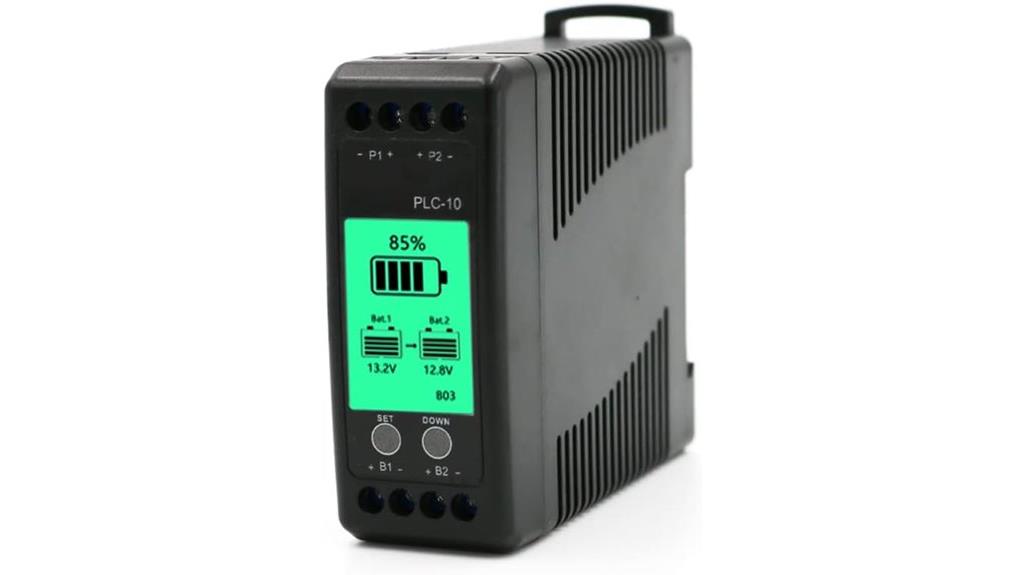
For anyone managing a mix of lead-acid and lithium batteries, a reliable battery equalizer like the iSunergy model offers a versatile solution. It supports various chemistries—Gel, Flood, AGM, Li-ion, LiFePO4—and accommodates 12V to 96V systems. Designed for series or parallel setups, it maintains balance by transferring energy bidirectionally when voltage differences exceed 50 millivolts. Easy to install with rail-type buckles, it provides automatic, long-term balancing without maintenance. While users praise its simplicity and effective voltage monitoring, some note concerns about durability, safety features, and performance consistency over time. Overall, it’s a practical tool for diverse battery configurations.
Best For: individuals managing mixed lead-acid and lithium battery systems in various applications seeking an affordable, automatic balancing solution.
Pros:
- Supports multiple chemistries and voltage configurations including 12V to 96V systems.
- Easy to install with rail-type buckles and provides automatic, maintenance-free balancing.
- Offers clear voltage readings and effective early-stage balancing, enhancing battery longevity.
Cons:
- Some users report inconsistent long-term performance and failure to maintain balance over time.
- Lacks safety features like fuses, raising concerns about durability and protection.
- Installation instructions can be complex, and device may emit bothersome high-pitched sounds at startup.
Factors to Consider When Choosing a Battery Balancer
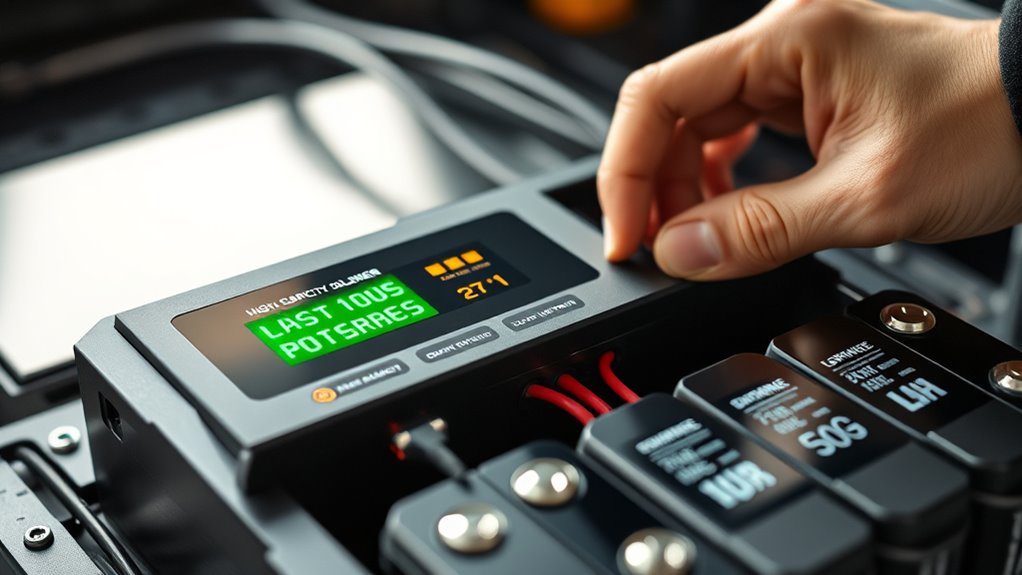
When selecting a battery balancer, I consider how well it matches my battery type and system requirements. I also check its balancing method, voltage and current limits, and safety features to guarantee reliable operation. Finally, ease of installation plays a big role in making the whole process straightforward and safe.
Compatibility With Batteries
Choosing the right battery balancer requires ensuring it’s compatible with your specific batteries and system setup. First, check that it supports your battery chemistry, whether LiFePO4, lead-acid, or lithium-ion, as each has different requirements. Make sure the device’s voltage range matches your system’s voltage, such as 12V, 24V, or 48V. Compatibility with your system configuration is also essential—whether you connect batteries in series, parallel, or a combination. Additionally, verify that the balancer can handle your batteries’ current capacity without exceeding its maximum rating, ensuring safe and effective operation. Finally, confirm that the connection interfaces, like clamps or ports, fit your battery terminals and wiring. Proper compatibility guarantees seamless integration and peak performance.
Balancing Methodology Type
Selecting the right balancing methodology impacts your system’s efficiency and performance. Active balancing methods transfer energy directly between batteries or cells, quickly correcting voltage disparities and enhancing longevity. They’re ideal for large or high-capacity systems where minimal energy loss is essential. Passive balancing, on the other hand, dissipates excess charge as heat through resistors. It’s simpler and more affordable but less efficient for extensive battery banks and can waste energy over time. Active balancers are better suited for demanding applications that require fast, precise balancing, while passive systems work well for smaller setups where cost and simplicity matter most. Your choice depends on your system’s size, capacity, and performance needs. Understanding these differences helps you select the most effective balancing approach for maximum efficiency and longevity.
Voltage and Current Limits
Ensuring your battery balancer’s voltage and current limits match your system’s requirements is essential for safe and effective operation. First, check that the voltage range aligns with your battery bank’s voltage to prevent under- or over-balancing, which can harm batteries. Next, verify the maximum current rating of the balancer matches or exceeds your batteries’ current capacity, ensuring it can handle charging and discharging loads efficiently. Pay attention to both continuous and peak current limits from the manufacturer; these define safe operation during full charge or discharge cycles. Also, consider the device’s current transfer capabilities, especially for high-capacity or fast-charging systems. Low current limits can lead to longer balancing times or insufficient balancing for large systems, so choose accordingly.
Safety and Protection Features
Safety and protection features are critical when evaluating a battery balancer, as they prevent damage to both the device and your batteries during operation. Reverse polarity protection is essential to avoid costly mistakes from incorrect wiring. Overcurrent and overvoltage protections safeguard batteries and the balancer from electrical surges, ensuring longevity and safety. High-temperature protection mechanisms help prevent overheating, especially in demanding environments, reducing fire risks or damage. Automatic shutoff or standby modes can stop over-balancing and conserve energy, extending battery life. Certifications like CE, RoHS, UL, and CEC demonstrate compliance with safety standards, giving you confidence in the device’s protective capabilities. Prioritizing these features ensures safe, reliable operation, and peace of mind for your power system.
Ease of Installation
When choosing a battery balancer, ease of installation can make a significant difference in how smoothly your setup goes. A user-friendly device should come with clear, detailed instructions or manuals, guiding you through each step. Devices with plug-and-play connectors or quick-release terminals simplify wiring and cut down installation time. Compact and lightweight units are easier to handle, especially in tight or hard-to-reach spaces. Balancers with pre-assembled cables or minimal wiring requirements reduce the need for extra tools or technical expertise. Additionally, clear labeling of connection points and built-in safety features help prevent wiring errors, making installation safer and more straightforward. Overall, prioritizing ease of installation ensures a hassle-free setup, saving you time and reducing potential frustrations.
Durability and Build Quality
Choosing a battery balancer that can withstand daily use and environmental factors is essential for long-term performance. A rugged casing made from impact-resistant plastics or metals protects against physical stress, especially in outdoor settings. High build quality, including precise soldering, sturdy connections, and quality components like low-resistance MOSFETs, ensures reliability and longevity. Features such as overvoltage, overcurrent, and thermal protections further reduce the risk of premature failure. Additionally, water and dust resistance ratings like IP65 or higher help the device endure harsh conditions. A well-constructed balancer maintains its performance over time, and reputable brands often offer products built with these durability standards. Prioritizing build quality guarantees your investment remains functional and dependable through sustained use.
Cost and Value
Cost and value are crucial factors to contemplate, as battery balancers come in a wide range of prices that reflect their features and build quality. Basic models can cost under $20, while advanced units with multiple features may exceed $150. Higher-priced balancers often include safety features, larger current capacity, or smart technology like Bluetooth monitoring. The best value strikes a balance between affordability, durability, effective performance, and safety protections. Sometimes, investing a bit more upfront can save money in the long run by extending battery life and preventing damage caused by imbalance. It’s essential to compare the initial cost with potential savings from improved system performance and longer-lasting batteries, ensuring you choose a balancer that offers the best overall cost-effectiveness for your needs.
Frequently Asked Questions
How Do Battery Balancers Impact Overall System Longevity?
Battery balancers substantially impact overall system longevity by ensuring each cell maintains an ideal charge level. When cells are balanced, it prevents overcharging or deep discharging, which can cause damage over time. I’ve seen how a well-balanced system reduces wear and tear, extending battery life and improving performance. Using a good balancer keeps the entire system healthier longer, saving money and reducing downtime in the long run.
Are There Specific Safety Features to Look for in a Battery Balancer?
Think of a battery balancer like a safety net catching any sparks before they cause harm. When choosing one, I look for features like overvoltage protection, temperature regulation, and automatic shutoff. These safety features act as vigilant guards, preventing potential hazards and ensuring my system runs smoothly. Prioritizing these safeguards helps me avoid accidents and keeps my power system safe and reliable.
Can Battery Balancers Be Used With Both New and Aging Batteries?
Yes, I can use battery balancers with both new and aging batteries. For new batteries, balancers help maintain ideal performance and extend lifespan by preventing uneven charging. With aging batteries, they can help balance out capacity differences, improving overall system reliability. I always guarantee compatibility and monitor performance closely, especially with older batteries, to avoid potential issues and maximize efficiency.
What Maintenance Is Required for Active Versus Passive Balancers?
Proper maintenance matters for both active and passive balancers. Active balancers need regular checks to guarantee their circuitry stays clean and cool, preventing overheating and ensuring peak operation. Passive balancers, on the other hand, require periodic inspection of resistors and connections for wear or damage. I recommend routine visual inspections and occasional testing to keep your balance system balanced, boosting battery lifespan and performance.
How Do Environmental Conditions Affect Battery Balancer Performance?
Environmental conditions critically impact battery balancer performance. High temperatures can cause overheating, reducing efficiency and potentially damaging components, so I guarantee proper cooling. Cold temperatures slow down chemical reactions, making balancing less effective, so I keep batteries insulated. Humidity and moisture can lead to corrosion, so I store equipment in dry environments. Regularly monitoring environmental factors helps me maintain ideal balancer function and extend battery life.
Conclusion
Choosing the right battery balancer is like tending a garden—each plant needs careful attention to flourish. As I’ve seen, the right balance nurtures your power system’s harmony, preventing corrosion and ensuring longevity. Think of these devices as the silent guardians of your energy flow, quietly maintaining order amidst chaos. When you pick wisely, you’re planting seeds of reliability and growth, watching your system thrive in the symphony of power that keeps your world moving smoothly.

